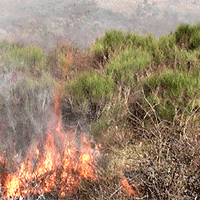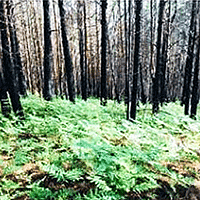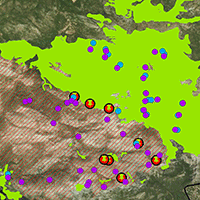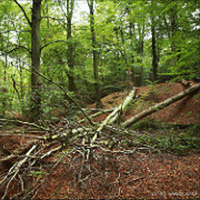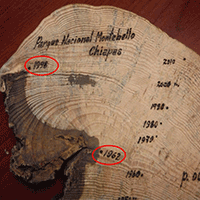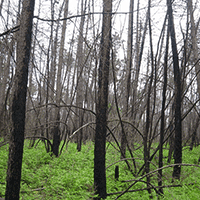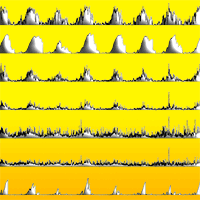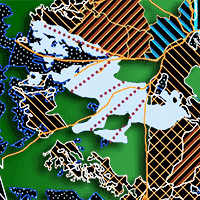Resilience against fire disturbance of Mediterranean vegetation has been frequently described. However, due to climatic change and abandonment of local land use practices, the fire regime is changing, probably leading to higher intensities and frequencies of disturbance events. The forthcoming scenario calls for a full understanding of post-disturbance tree recruitment processes, structural resilience and possible consequences on the overall forest biodiversity. In particular, knowledge on severe crown fires’ effects on forest stand structural attributes needs to be further explored. In this work, we describe and quantify fire impact and short-term response of a Mediterranean forest affected by high severity crown fires, focusing on the compositional and structural diversity of living and dead trees, spatial pattern of fire-induced mortality, recovery dynamics of tree species. The analysis, based on a synchronic approach, was carried out within four burned and two not burned fully stem-mapped research plots located in NW Italy, belonging to two forest categories differing for their main tree restoration strategies. Distance-dependent and distance-independent indices were applied to assess structural diversity dynamics over time since fire occurrence. Within the analyzed forests fire was found to affect mostly forest structure rather than its composition. Number of snags largely increases immediately after the fire, but it levels off due to their fall dynamics. Regeneration strategies and fire severity influenced species abundance and consequently diversity patterns. Stem diameter and height diversity were modified as well, with a strong increase in the first post-fire year and a sharp reduction six years after the disturbance. Fire determined also a higher heterogeneity in crown cover and vertical structure. Spatial patterns of surviving trees and snags were greatly affected by fire, producing an increase in aggregation and segregation mechanisms. Autosuccessional processes are supposed to preserve current forest structure and composition, but the ecosystem self-restoring capability should be analyzed in the light of the possible changes in fire regime.
Keywords
, , , ,
Citation
Marzano R, Lingua E, Garbarino M (2012). Post-fire effects and short-term regeneration dynamics following high-severity crown fires in a Mediterranean forest. iForest 5: 93-100. - doi: 10.3832/ifor0612-005
Academic Editor
Roberto Tognetti
Paper history
Received: Oct 23, 2011
Accepted: Apr 05, 2012
First online: May 30, 2012
Publication Date: Jun 29, 2012
Publication Time: 1.83 months
© SISEF - The Italian Society of Silviculture and Forest Ecology 2012
Open Access
This article is distributed under the terms of the Creative Commons Attribution-Non Commercial 4.0 International (https://creativecommons.org/licenses/by-nc/4.0/), which permits unrestricted use, distribution, and reproduction in any medium, provided you give appropriate credit to the original author(s) and the source, provide a link to the Creative Commons license, and indicate if changes were made.

Breakdown by View Type
(Waiting for server response...)
Article Usage
Total Article Views: 65531
(from publication date up to now)
Breakdown by View Type
HTML Page Views: 50956
Abstract Page Views: 5246
PDF Downloads: 7446
Citation/Reference Downloads: 48
XML Downloads: 1835
Web Metrics
Days since publication: 4963
Overall contacts: 65531
Avg. contacts per week: 92.43
Article Citations
Article citations are based on data periodically collected from the Clarivate Web of Science web site
(last update: Mar 2025)
Total number of cites (since 2012): 31
Average cites per year: 2.21
Publication Metrics
by Dimensions ©
Articles citing this article
List of the papers citing this article based on CrossRef Cited-by.
(1)
Aakala T, Kuuluvainen T, De Grandpré L, Gauthier S (2007)Trees dying standing in the northeastern boreal old-growth forests of Quebec: spatial patterns, rates, and temporal variation. Canadian Journal of Forest Research 37: 50-61.
CrossRef |
Gscholar
(2)
Agee JK (1993)Fire ecology of pacific northwest forests. Island Press, Washington, DC, USA.
Gscholar
(3)
Attiwill PM (1994)The disturbance of forest ecosystems. The ecological basis for conservative management. Forest Ecology and Management 63: 247-300.
CrossRef |
Gscholar
(4)
Beghin R, Lingua E, Garbarino M, Lonati M, Bovio G, Motta R, Marzano R (2010)forest regeneration under different post-fire restoration practices in the northwestern Italian Alps. Ecological Engineering 36: 1365-1372.
CrossRef |
Gscholar
(5)
Blondel J, Aronson J, Bodiou J-Y, Boeuf G (2010)The Mediterranean region. Biological diversity in space and time. Oxford University Press, New York, USA.
Gscholar
(6)
Bond WJ, van Wilgen BW (1996)Fire and plants. Chapman & Hall, London, UK.
Gscholar
(7)
Brillouin L (1956)Science and information theory. Academic Press, New York, USA.
Gscholar
(8)
Capitanio R, Carcaillet C (2008)Post-fire Mediterranean vegetation dynamics and diversity: a discussion of succession models. Forest Ecology and Management 255: 431-439.
CrossRef |
Gscholar
(9)
Buscardo E, Freitas H, Pereira JS, De Angelis P (2011)Common environmental factors explain both ectomycorrhizal species diversity and pine regeneration variability in a post-fire Mediterranean forest. Mycorrhiza 21: 549-558.
CrossRef |
Gscholar
(10)
Carvalho A, Flannigan M, Logan K, Miranda A, Borrego C (2008)Fire activity in Portugal and its relationship to weather and the Canadian fire weather index system. International Journal of Wildland Fire 17: 328-338.
CrossRef |
Gscholar
(11)
Chambers CL, Mast JN (2005)Ponderosa pine snag dynamics and cavity excavation following wildfire in northern Arizona. Forest Ecology and Management 216: 227-240.
CrossRef |
Gscholar
(12)
Davis MA, Curran C, Tietmeyer A, Miller A (2005)Dynamic tree aggregation patterns in a species-poor temperate woodland disturbed by fire. Journal of Vegetation Science 16: 167-174.
CrossRef |
Gscholar
(13)
De las Heras J, Martínez-Sánchez JJ, González-Ochoa AI, Ferrandis P, Herranz JM (2002)Establishment of
Pinus halepensis Mill. saplings following fire: effects of competition with shrub species. Acta Oecologica 23: 91-97.
CrossRef |
Gscholar
(14)
Dury M, Hambuckers A, Warnant P, Henrot A, Favre E, Ouberdous M, François L (2011)Responses of European forest ecosystems to 21
st century climate: assessing changes in interannual variability and fire intensity. I-Forest 4: 82-99
CrossRef |
Gscholar
(15)
Everett R, Lehmkuhl J, Schellhaas R, Ohlson P, Keenum D, Riesterer H, Spurbeck D (1999)Snag dynamics in a chronosequence of 26 wildfires on the east slope of the cascade range in Washington State, USA. International Journal of Wildland Fire 9: 223-234.
CrossRef |
Gscholar
(16)
Fernandes PM, Rigolot E (2007)The fire ecology and management of maritime pine (
Pinus pinaster Ait.). Forest Ecology and Management 241: 1-13.
CrossRef |
Gscholar
(17)
Fulé PZ, Covington WW (1994)Fire regime disruption and pine-oak forest structure in the Sierra Madre Occidental, Durango, Mexico. Restoration Ecology 2: 261-272.
CrossRef |
Gscholar
(18)
Fulé PZ, Covington WW (1998)Spatial patterns of Mexican pine-oak forests under different recent fire regimes. Plant Ecology 134: 197-209.
CrossRef |
Gscholar
(19)
Getis A, Franklin J (1987)Second-order neighborhood analysis of mapped point patterns. Ecology 68: 473-477.
CrossRef |
Gscholar
(20)
Gillson L (2009)Landscapes in time and space. Landscape Ecology 24: 149-155.
CrossRef |
Gscholar
(21)
González JR, Pukkala T (2007)Characterization of forest fires in Catalonia (north-east Spain). European Journal of Forest Research 126: 421-429.
CrossRef |
Gscholar
(22)
Good P, Moriondo M, Giannakopoulos C, Bindi M (2008)The meteorological conditions associated with extreme fire risk in Italy and Greece: relevance to climate model studies. International Journal of Wildland Fire 17:155-165.
CrossRef |
Gscholar
(23)
Goreaud F, Pélissier R (2003)Avoiding misinterpretation of biotic interactions with the intertype -function: population independence
vs. random labelling hypothesis. Journal of Vegetation Science 14: 681-692.
CrossRef |
Gscholar
(24)
Haase P (1995)Spatial pattern analysis in ecology based on Ripley’s -function: introduction and methods of edge correction. Journal of Vegetation Science 6: 575-582.
CrossRef |
Gscholar
(25)
Haase P (2001)Can isotropy
vs. anisotropy in the spatial association of plant species reveal physical
vs. biotic facilitation? Journal of Vegetation Science 12: 127-136.
CrossRef |
Gscholar
(26)
Hanes TL (1971)Succession after fire in the chaparral of southern California. Ecological Monographs 41: 27-52.
CrossRef |
Gscholar
(27)
Hodgkinson KC (1998)Sprouting success of shrubs after fire: height-dependent relationships for different strategies. Oecologia 115: 64-72.
CrossRef |
Gscholar
(28)
Huston MA (1994)Biological diversity: the coexistence of species on changing landscapes. Cambridge University Press, Cambridge, UK.
Gscholar
(29)
Johnson EA (1992)Fire and vegetation dynamics: studies from the North American boreal forest. Cambridge University Press, New York, USA.
Gscholar
(30)
Kane JM, Meinhardt KA, Chang T, Cardall BL, Michalet R, Whitham TG (2011)Drought-induced mortality of a foundation species (
Juniperus monosperma) promote positive afterlife effects in understory vegetation. Plant Ecology 212:733-741.
CrossRef |
Gscholar
(31)
Keeley JE (1986)Resilience of mediterranean shrub communities to fires. In: “Resilience in mediterranean-type ecosystems” (Dell B, Hopkins AJM, Lamont BB eds). W Junk, Dordrecht, The Netherlands, pp. 95-112.
Gscholar
(32)
Keen FP (1929)How soon do yellow pine snags fall? Journal of Forestry 27: 735-737.
Gscholar
(33)
Kenkel NC (1988)Pattern of self-thinning in jack pine: testing the random mortality hypothesis. Ecology 69: 1017-1024.
CrossRef |
Gscholar
(34)
Kuuluvainen T, Järvinen E, Hokkanen TJ, Rouvinen S, Heikkinen K (1998)Structural heterogeneity and spatial autocorrelation in a natural mature
Pinus sylvestris dominated forest. Ecography 21: 159-174.
CrossRef |
Gscholar
(35)
Kuuluvainen T, Leinonen K, Nygren M, Penttinen A (1996)Statistical opportunities for comparing stand structural heterogeneity in managed and primeval forests: an example from boreal spruce forest in southern Finland. Silva Fennica 30: 315-328.
Online |
Gscholar
(36)
Lavorel S, Canadell J, Rambal S, Terradas J (1998)Mediterranean terrestrial ecosystems: research priorities on global change effects. Global Ecology and Biogeography Letters 7: 157-166.
CrossRef |
Gscholar
(37)
Lavorel S (1999)Ecological diversity and resilience of mediterranean vegetation to disturbance. Diversity and Distributions 5: 3-13.
CrossRef |
Gscholar
(38)
Le Houérou HN (1987)Vegetation wildfires in the Mediterranean basin: evolution and trends. Ecologia Mediterranea 13: 13-24.
Gscholar
(39)
Lloret F, Estevan H, Vayreda J, Terradas J (2005)Fire regenerative syndromes of forest woody species across fire and climatic gradients. Oecologia 146: 461-468.
CrossRef |
Gscholar
(40)
Lloret F, Marí G (2001)A comparison of medioeval and the current fire regimes in managed pine forests of Catalonia (NE Spain). Forest Ecology and Management 141: 155-163.
CrossRef |
Gscholar
(41)
Lloret F, Pausas JG, Vilà M (2003)Responses of Mediterranean plant species to different fire frequencies in Garraf Natural Park (Catalonia, Spain): Field observations and modelling predictions. Plant Ecology 167: 223-235.
CrossRef |
Gscholar
(42)
Lloret F, Peñuelas J, Estiarte M (2004)Experimental evidence of reduced diversity of seedlings due to climate modification in a Mediterranean-type community. Global Change Biology 10: 248-258.
CrossRef |
Gscholar
(43)
Lloret F, Peñuelas J, Prieto P, Llorens L, Estiarte M (2009)Plant community changes induced by experimental climate change: seedling and adult species composition. Perspectives in Plant Ecology, Evolution and Systematics 11: 53-63.
CrossRef |
Gscholar
(44)
Lloret F, Vilà M (2003)Diversity patterns of plant functional types in relation to fire regime and previous land use in Mediterranean woodlands. Journal of Vegetation Science 14: 387-398.
CrossRef |
Gscholar
(45)
Lotwick HW, Silverman B.W (1982)Methods for analysing spatial processes of several types of points. Journal of the Royal Statistical Society B 44: 406-413.
Online |
Gscholar
(46)
Magurran AE (2004)Measuring biological diversity. Blackwell Science, Oxford, UK.
Gscholar
(47)
Marzano R (2006)Assessing biodiversity in a changing fire regime: post- fire dynamics in a Mediterranean area. PhD thesis, Dottorato di Ricerca in Scienze Agrarie, Forestali e Agroalimentari (XVIII ciclo), University of Torino, pp. 204.
Gscholar
(48)
McKenzie D, Alvarado E, Peterson DL (1996)Extrapolation problems in modeling fire effects at large spatial scales: A review. International Journal of Wildland Fire 6: 165-176.
CrossRef |
Gscholar
(49)
Moravec J (1990)Regeneration of NW African
Pinus halepensis forests following fire. Vegetatio 87: 29-36.
CrossRef |
Gscholar
(50)
Moreira F, Ferreira PG, Rego FC, Bunting S (2001)Landscape changes and breeding bird assemblages in northwestern Portugal: the role of fire. Landscape Ecology 16: 175-187.
CrossRef |
Gscholar
(51)
Moreno JM, Oechel WC (1994)The role of fire in Mediterranean type ecosystems. Springer-Verlag, Berlin, Germany.
Gscholar
(52)
Mouillot D, Rambal S, Joffre R (2002)Simulating climate change impacts on fire frequency and vegetation dynamics in a Mediterranean-type ecosystem. Global Change Biology 8: 1-15.
CrossRef |
Gscholar
(53)
Naveh Z (1974)Effects of fire in the Mediterranean Region. In: “Fire and ecosystems” (Kozlowski TT, Ahlgren CE eds). Academic Press, New York, USA, pp. 401-434.
Gscholar
(54)
Naveh Z (1975)The evolutionary significance of fire in the Mediterranean region. Vegetatio 29: 199-208.
CrossRef |
Gscholar
(55)
Neumann M, Starlinger F (2001)The significance of different indices for stand structure and diversity in forests. Forest Ecology and Management 145: 91-106.
CrossRef |
Gscholar
(56)
Pausas JG (1999a)The response of plant functional types to changes in the fire regime in Mediterranean ecosystems. A simulation approach. Journal of Vegetation Science 10: 717-723.
CrossRef |
Gscholar
(57)
Pausas JG (1999b)Mediterranean vegetation dynamics: modelling problems and functional types. Plant Ecology 140: 27-39.
CrossRef |
Gscholar
(58)
Pausas JG, Fernández-Muñoz S (2012)Fire regime changes in the Western Mediterranean Basin: from fuel-limited to drought-driven fire regime. Climatic Change 110 (1-2): 215-226.
CrossRef |
Gscholar
(59)
Peñuelas J, Filella I (2001)Phenology: responses to a warming world. Science 294 (5543): 793-795.
CrossRef |
Gscholar
(60)
Peñuelas J, Filella I, Comas P (2002)Changed plant and animal life cycles from 1952 to 2000 in the Mediterranean region. Global Change Biology 8: 531-544.
CrossRef |
Gscholar
(61)
Piñol J, Terradas J, Lloret F (1998)Climate warming, wildfire hazard, and wildfire occurrence in coastal eastern Spain. Climatic Change 38: 345-357.
CrossRef |
Gscholar
(62)
Quevedo L, Rodrigo A, Espelta JM (2007)Post-fire resprouting ability of 15 non-dominant shrub and tree species in Mediterranean areas of NE Spain. Annals of Forest Sciences 64: 883-890.
CrossRef |
Gscholar
(63)
Rebertus AJ, Williamson GB, Moser EB (1989)Fire-induced changes in
Quercus laevis spatial pattern in Florida sandhills. Journal of Ecology 77: 638-650.
CrossRef |
Gscholar
(64)
Ripley BD (1977)Modelling spatial patterns (with discussion). Journal of the Royal Statistical Society B 39: 172-212.
Online |
Gscholar
(65)
Rodrigo A, Retana J, Picò FX (2004)Direct regeneration is not the only response of Mediterranean forest to large fires. Ecology 85: 716-729.
CrossRef |
Gscholar
(66)
Rouvinen S, Kuuluvainen T (2005)Tree diameter distributions in natural and managed old
Pinus sylvestris-dominated forests. Forest Ecology and Management 208: 45-61.
CrossRef |
Gscholar
(67)
Scarascia-Mugnozza G, Oswald H, Piussi P, Radoglou K (2000)Forests of the Mediterranean region: gaps in knowledge and research needs. Forest Ecology and Management 132: 97-109.
CrossRef |
Gscholar
(68)
Trabaud L (1987a)The role of fire in ecological systems. SPB Academic Publishers, The Hague, The Netherlands.
Gscholar
(69)
Trabaud L (1987b)Natural and prescribed fire: survival strategies of plants and equilibrium in Mediterranean ecosystems. In: “Plant response to stress. Functional analysis in Mediterranean ecosystems” (Tenhunen JD, Catarino FM, Lange OL, Oechel WC eds), Springer, Berlin, Germany, pp. 607-621.
Gscholar
(70)
Trabaud L (1991)Fire regimes and phytomass growth dynamics in a garrigue. Journal of Vegetation Science 2: 307-314.
CrossRef |
Gscholar
(71)
Trabaud L (1994)Postfire plant community dynamics in the Mediterranean Basin. In: “The role of fire in Mediterranean-type Ecosystems” (Moreno JM, Oechel WC eds). Ecological Studies, vol. 107, Springer, New York, USA, pp. 1-15.
Gscholar
(72)
Turner MG, Hargrove WW, Gardner RH, Romme WH (1994)Effects of fire on landscape heterogeneity in Yellowstone National Park, Wyoming. Journal of Vegetation Science 5 (5): 731-742.
CrossRef |
Gscholar
(73)
Van Wagner CE (1977)Conditions for the start and spread of crown fire. Canadian Journal of Forest Research 7: 23-34.
CrossRef |
Gscholar
(74)
Vázquez A, Moreno JM (2001)Spatial distribution of forest fires in Sierra de Gredos (Central Spain). Forest Ecology and Management 147: 55-65.
CrossRef |
Gscholar
(75)
Vega JA, Fernández C, Pérez-Gorostiaga P, Fonturbel T (2010)Response of maritime pine
(Pinus pinaster Ait.) recruitment to fire severity and post-fire management in a coastal burned area in Galicia (NW Spain). Plant ecology 206: 297-308.
CrossRef |
Gscholar
(76)
Velez R (2000)La defensa contra incendios forestales. Fundamentos y experiencias (forest fire prevention. Principles and experiences). McGraw-Hill, Madrid, Spain.
Gscholar
(77)
Verdú M, Pausas JG, Segarra-Moragues JG, Ojeda F (2007)Burning phylogenies: fire, molecular evolutionary rates, and diversification. Evolution 61(9): 2195-2204.
CrossRef |
Gscholar
(78)
Whelan RJ (1995)The ecology of fire. Cambridge University Press, Cambridge, UK.
Gscholar
(79)
Wiegand T, Moloney KA (2004)Rings, circles, and null-models for point pattern analysis in ecology. Oikos 104: 209-229.
CrossRef |
Gscholar
(80)
Wiegand T, Moloney KA, Milton SJ (1998)Population dynamics, disturbance, and pattern evolution: identifying the fundamental scales of organization in a model ecosystem. The American Naturalist 152: 321-337.
CrossRef |
Gscholar
(81)
Zedler PH, Gautier CR, McMaster GS (1983)Vegetation change in response to extreme events: the effect of a short interval between fires in California chaparral and coastal scrub. Ecology 64: 809-818.
CrossRef |
Gscholar
